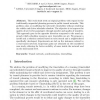Free Online Productivity Tools
i2Speak
i2Symbol
i2OCR
iTex2Img
iWeb2Print
iWeb2Shot
i2Type
iPdf2Split
iPdf2Merge
i2Bopomofo
i2Arabic
i2Style
i2Image
i2PDF
iLatex2Rtf
Sci2ools
IEAAIE
2010
Springer
2010
Springer
Improving Timetable Quality in Scheduled Transit Networks
This work deals with an original problem with regard to the traditionally sequential planning process in public transit networks. This problem aims at modifying the network's timetables without rendering the vehicle and driver schedules obsolete. The objective is to improve the quality of service for passengers through number and quality of transfers. This approach goes in the opposite direction compared to the usual approach which schedules resources once timetables are set. We propose a model and a solution method based on tabu search and a neighborhood specifically developed. Experiments are led on five instances related to a real transit network. Important gains are obtained on the considered case study, allowing for better mobility of users inside the network and on the intermodal level.
Artificial Intelligence | IEAAIE 2010 | Public Transit Networks | Sequential Planning Process | Transit Network |
| Added | 13 Feb 2011 |
| Updated | 13 Feb 2011 |
| Type | Journal |
| Year | 2010 |
| Where | IEAAIE |
| Authors | Valérie Guihaire, Jin-Kao Hao |
Comments (0)

